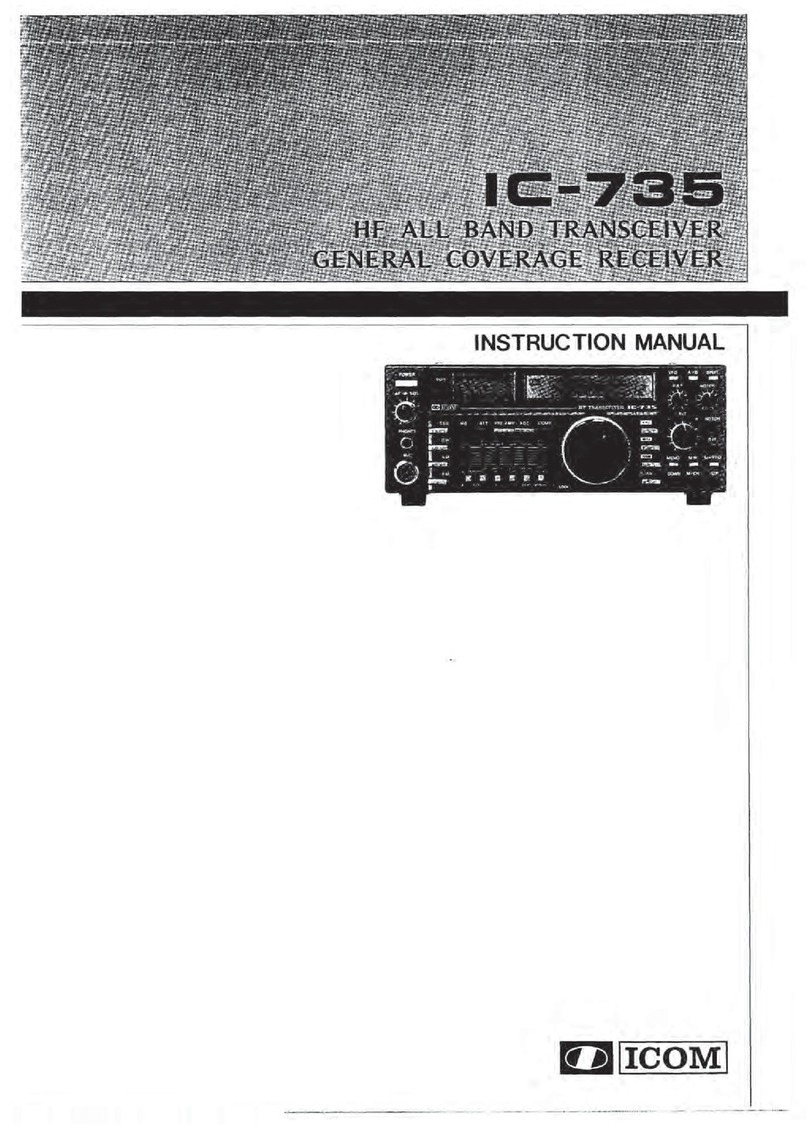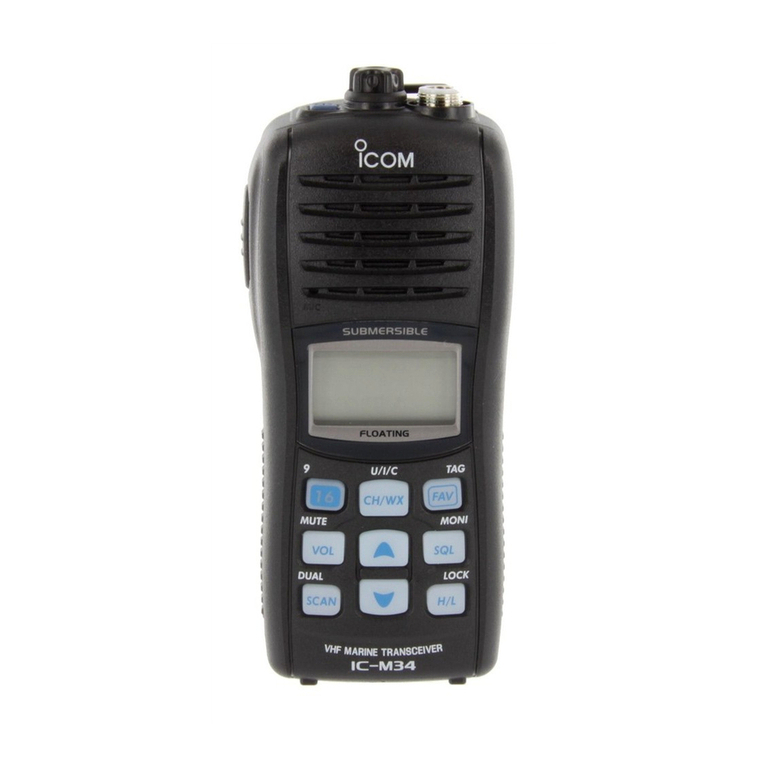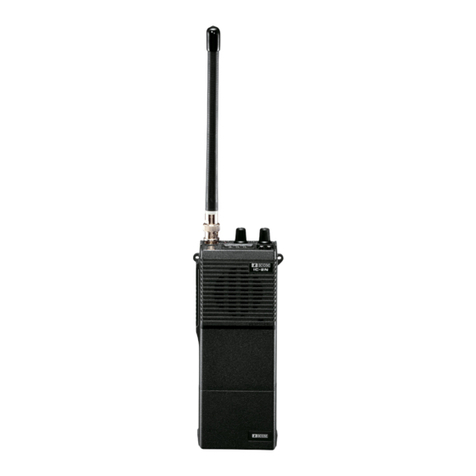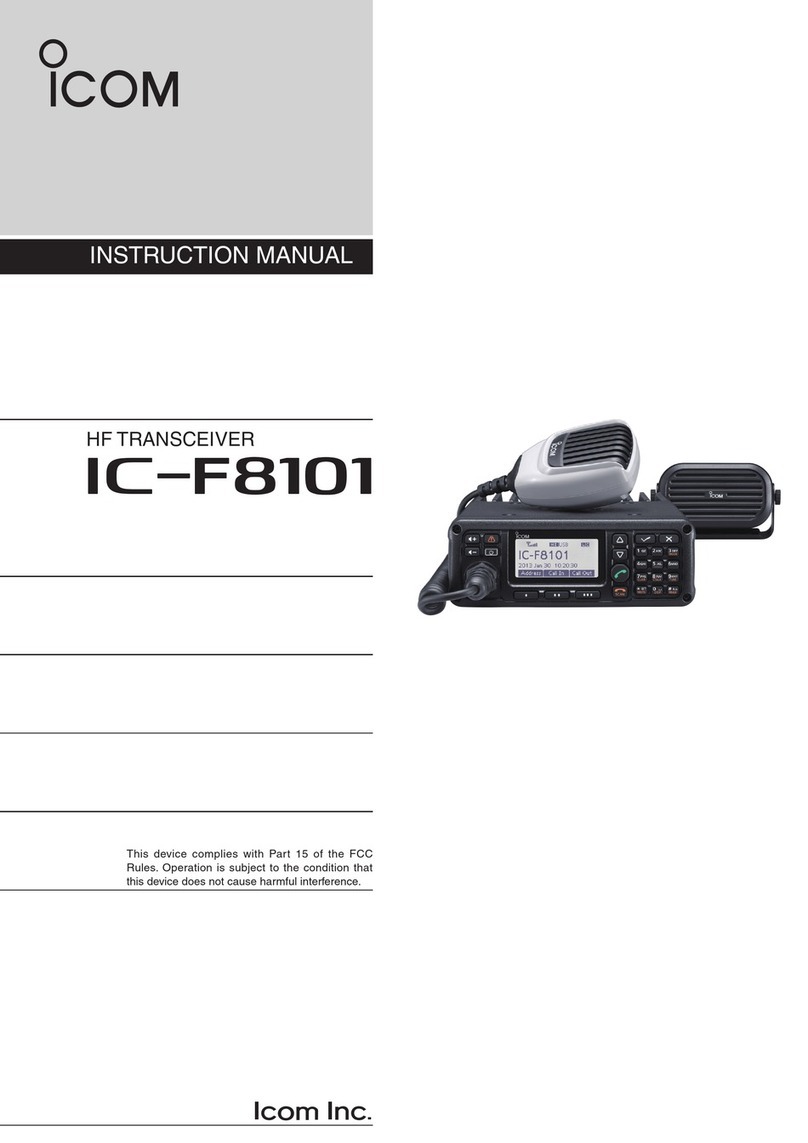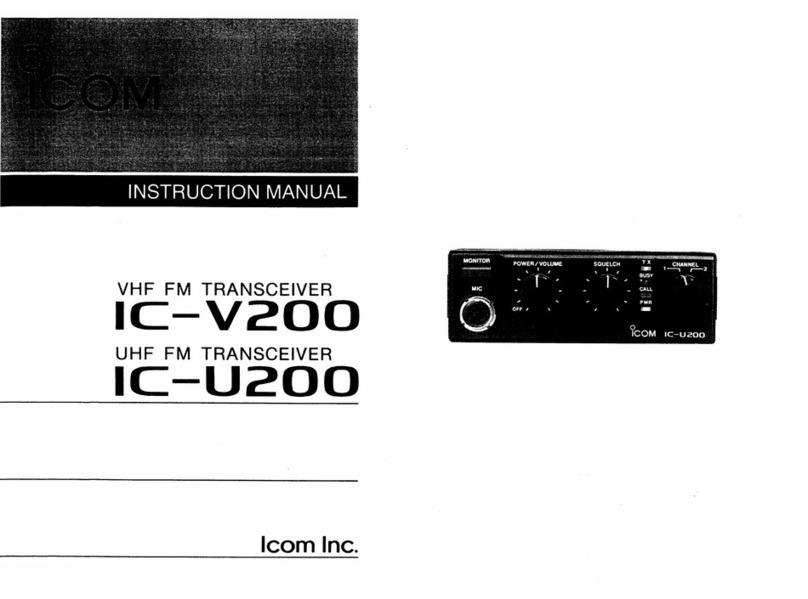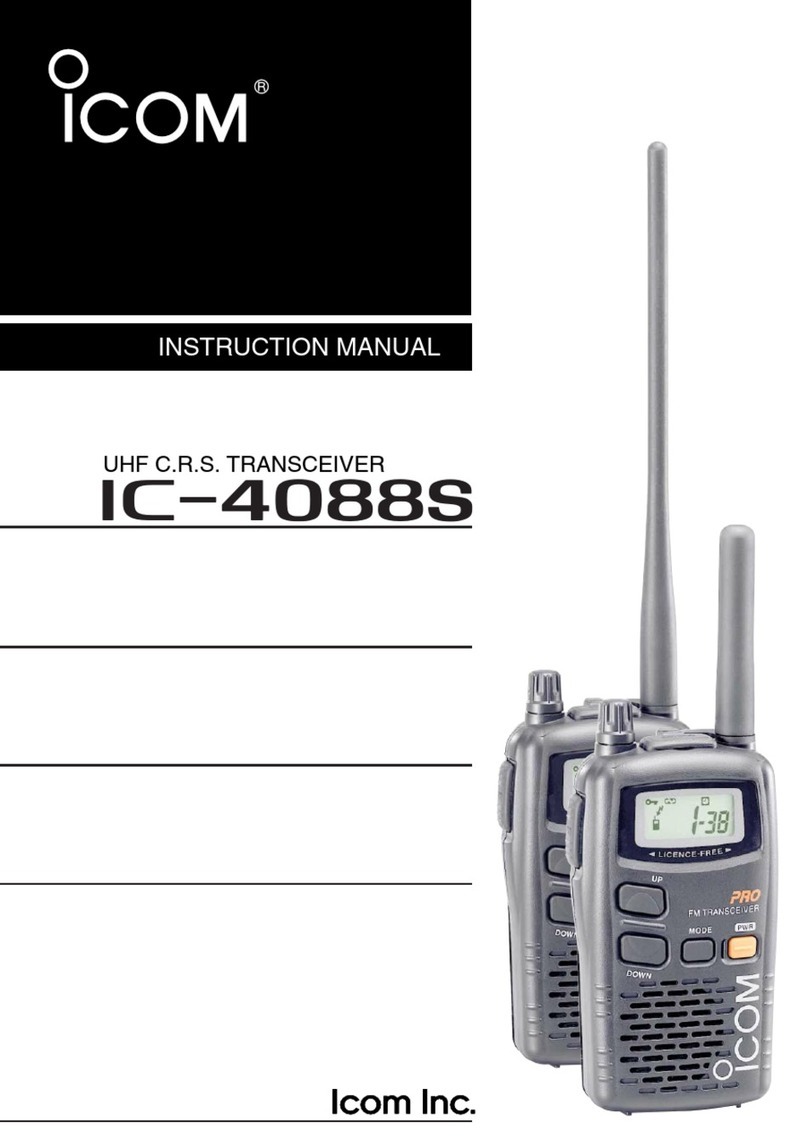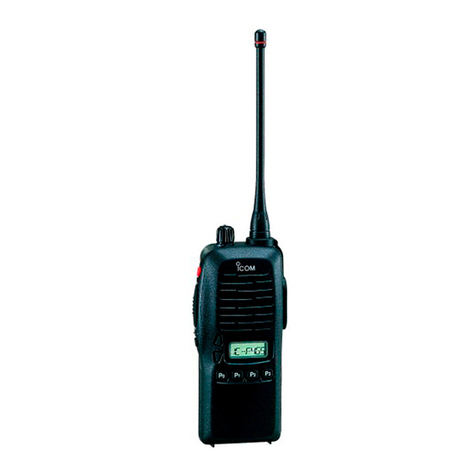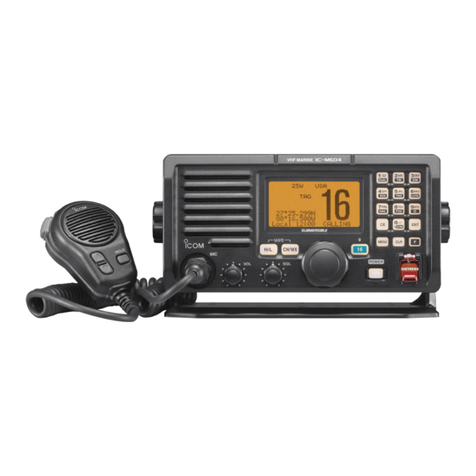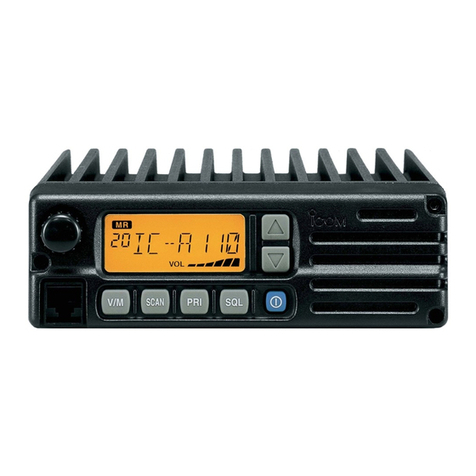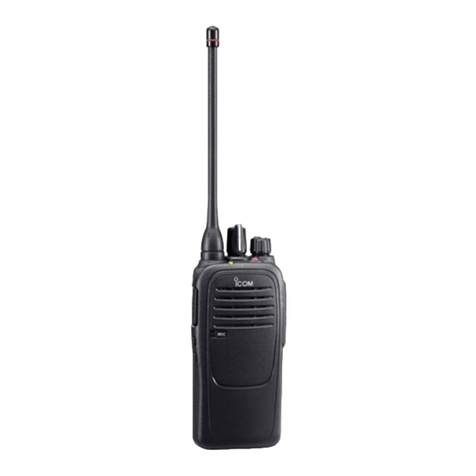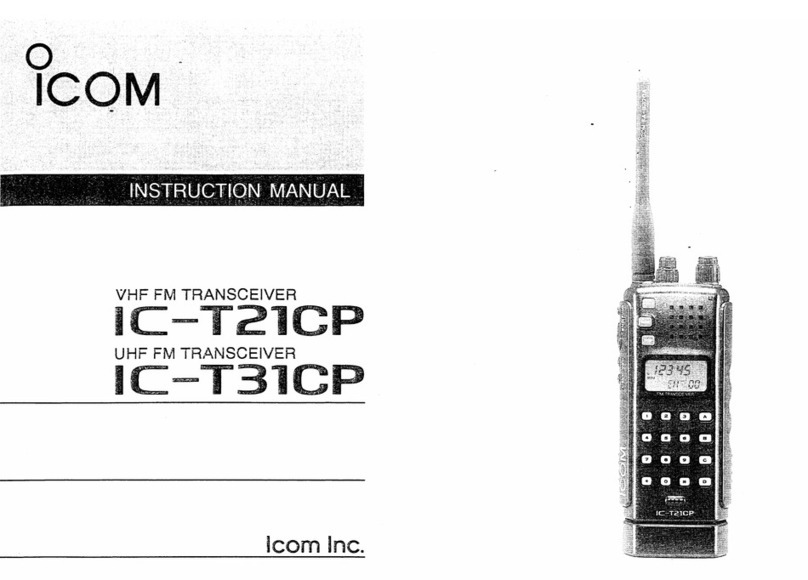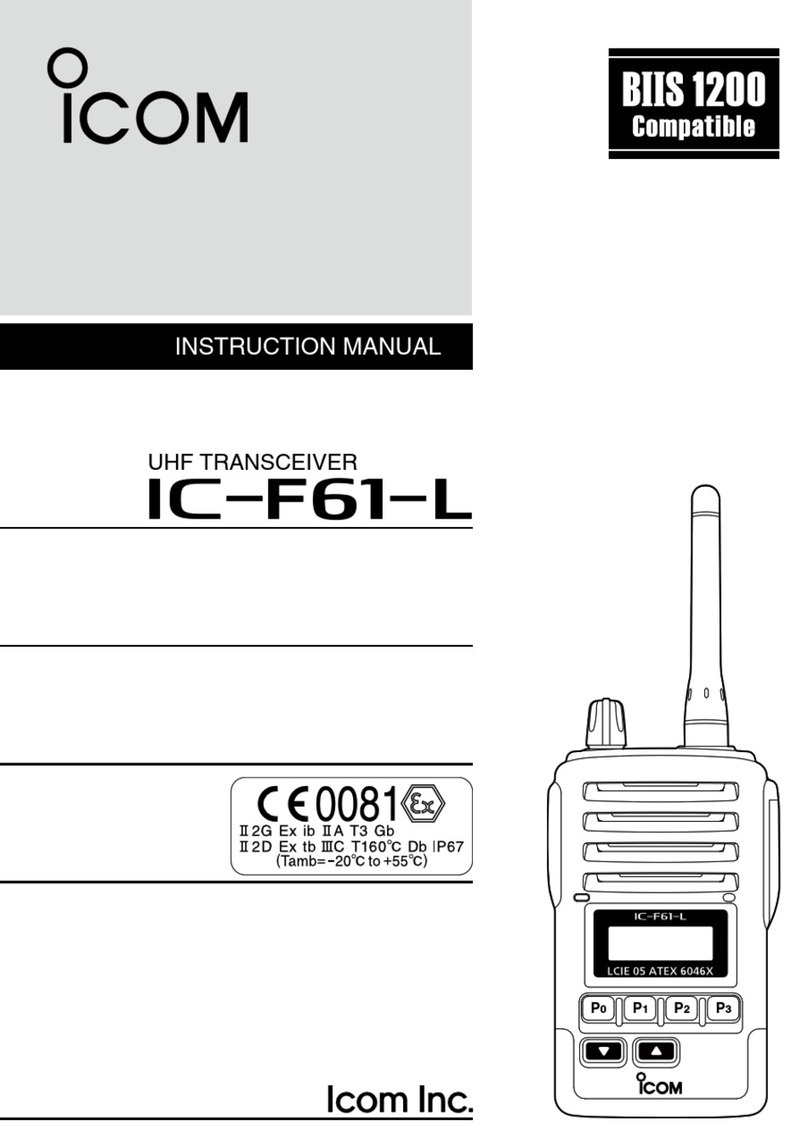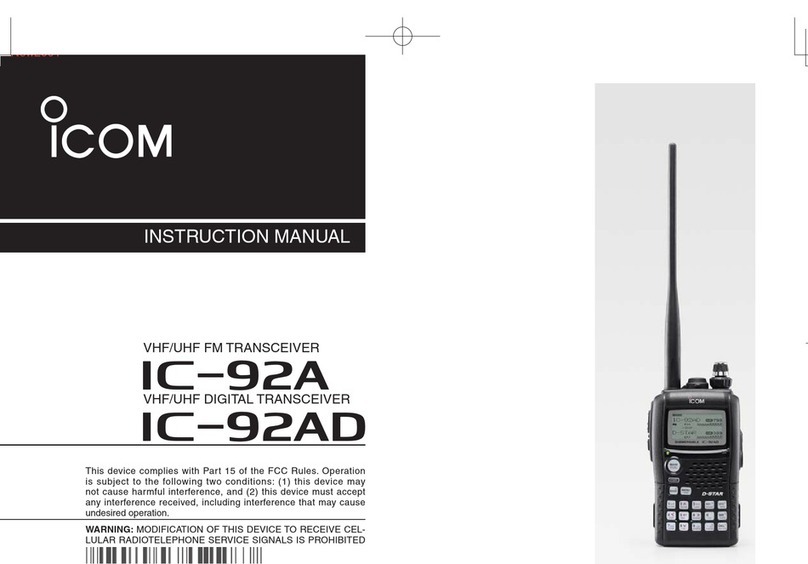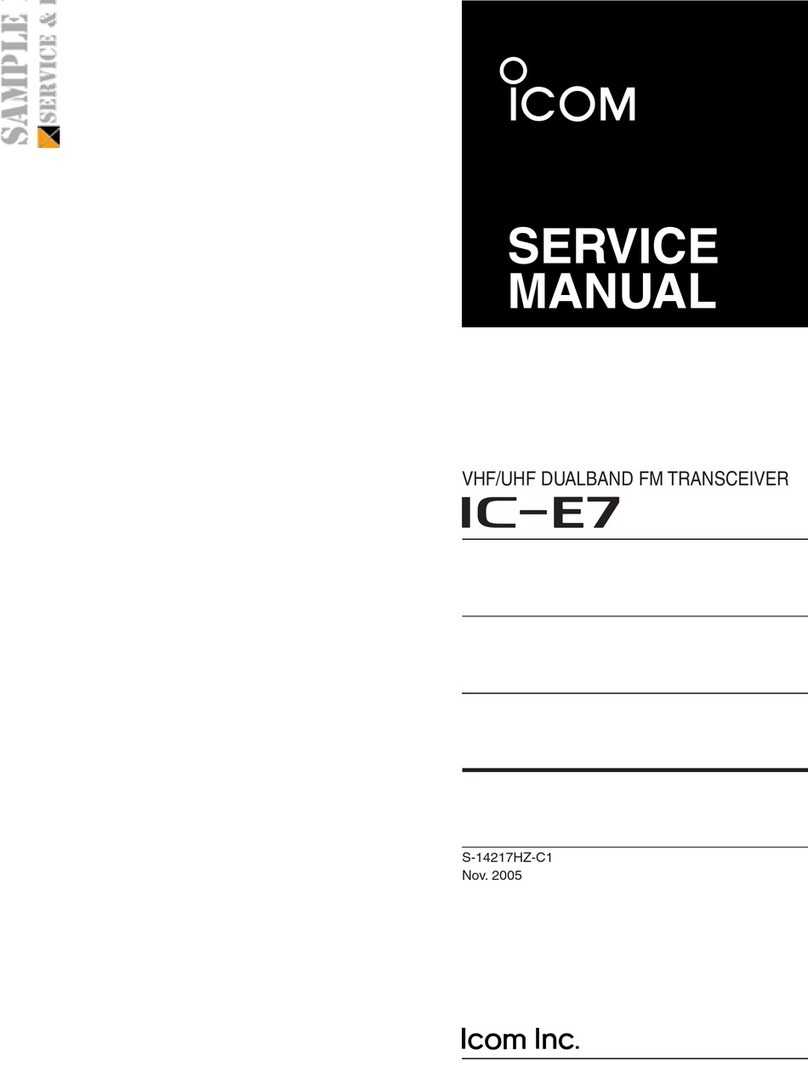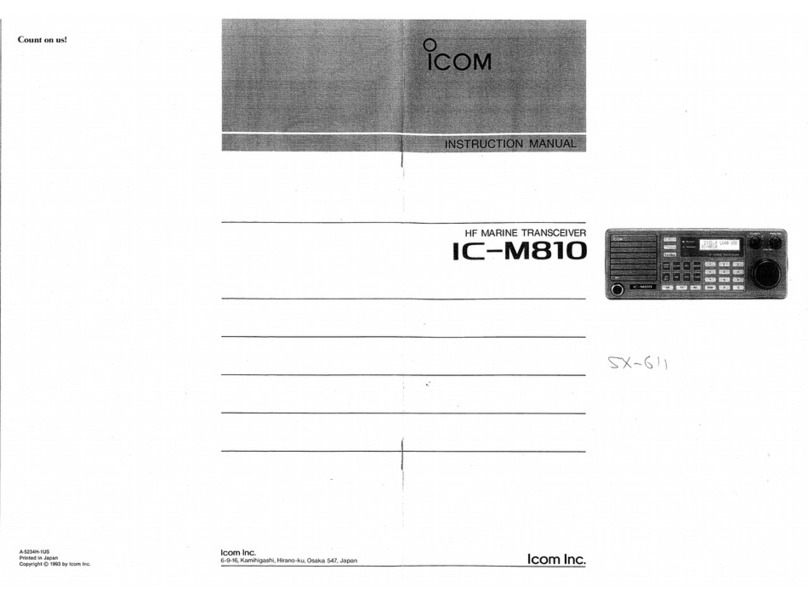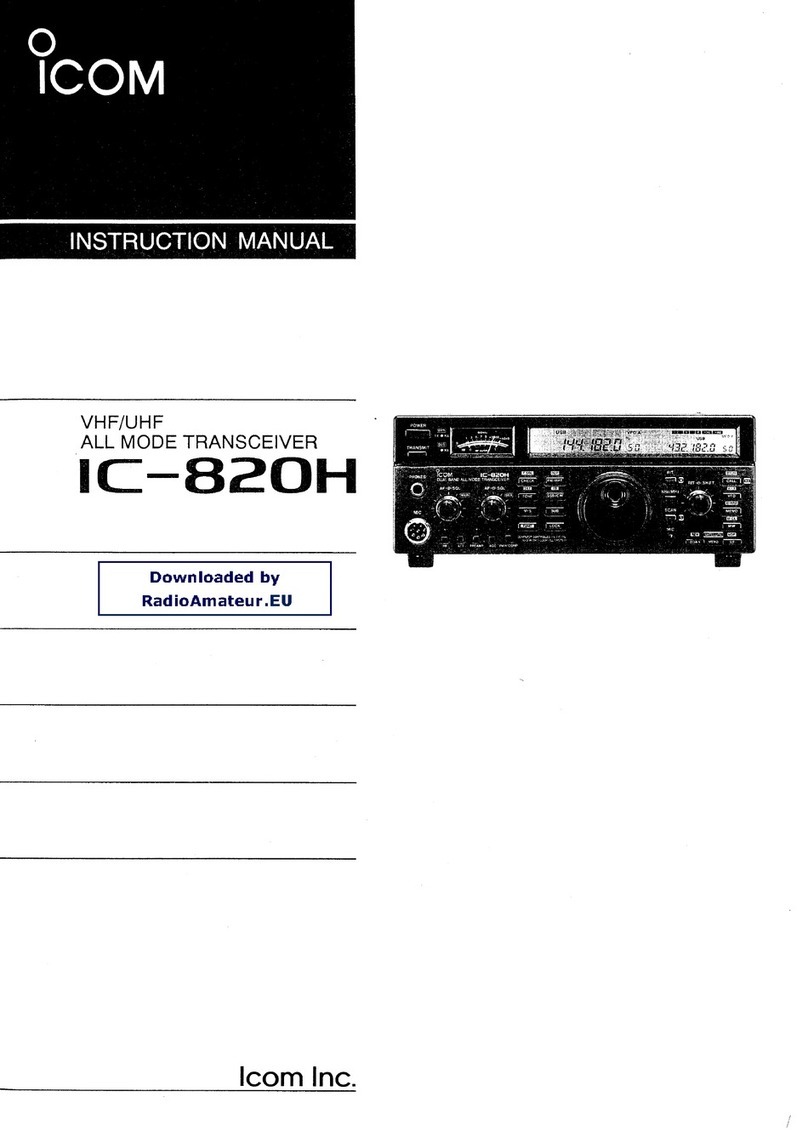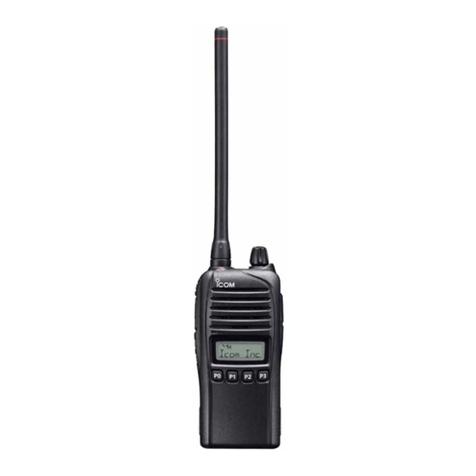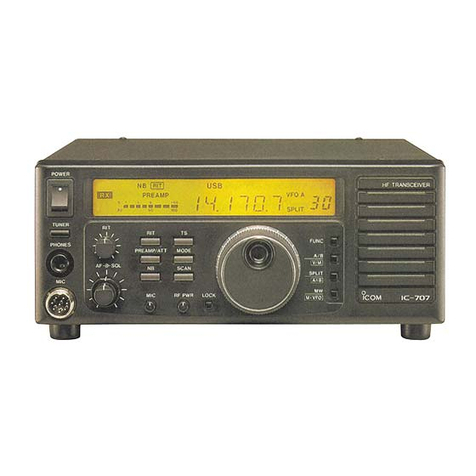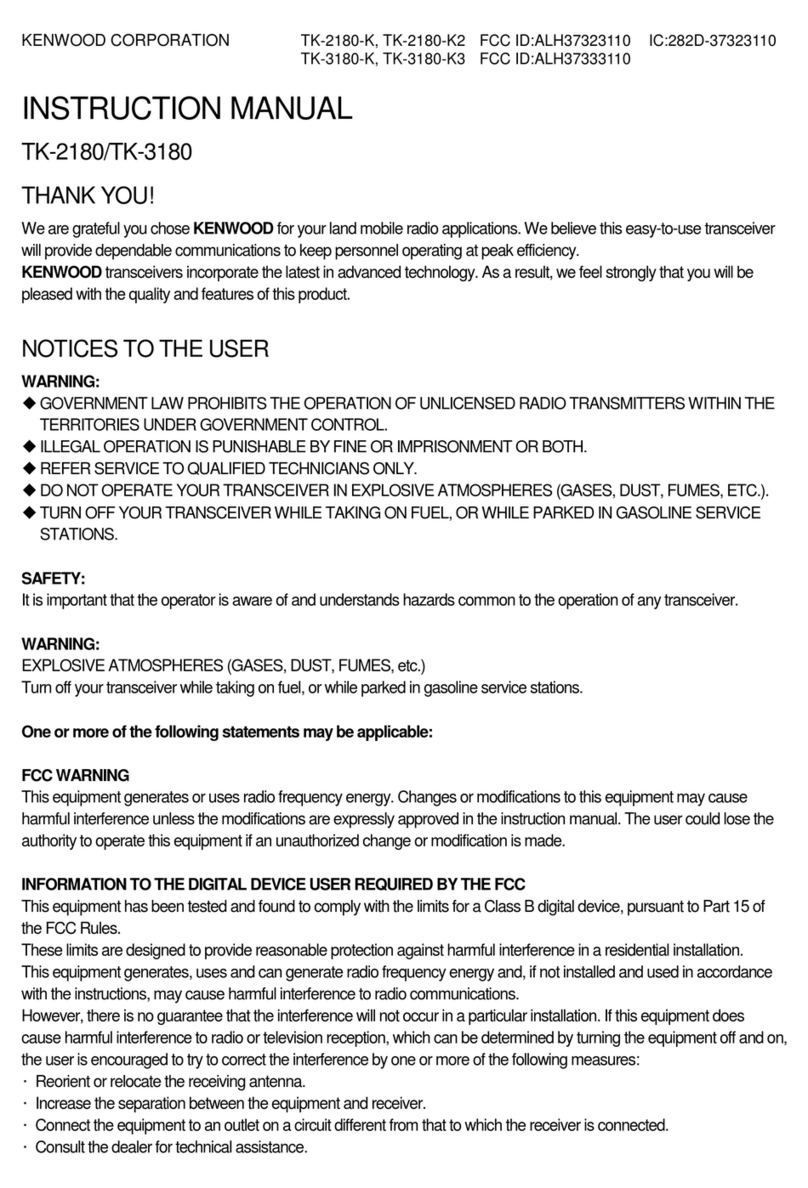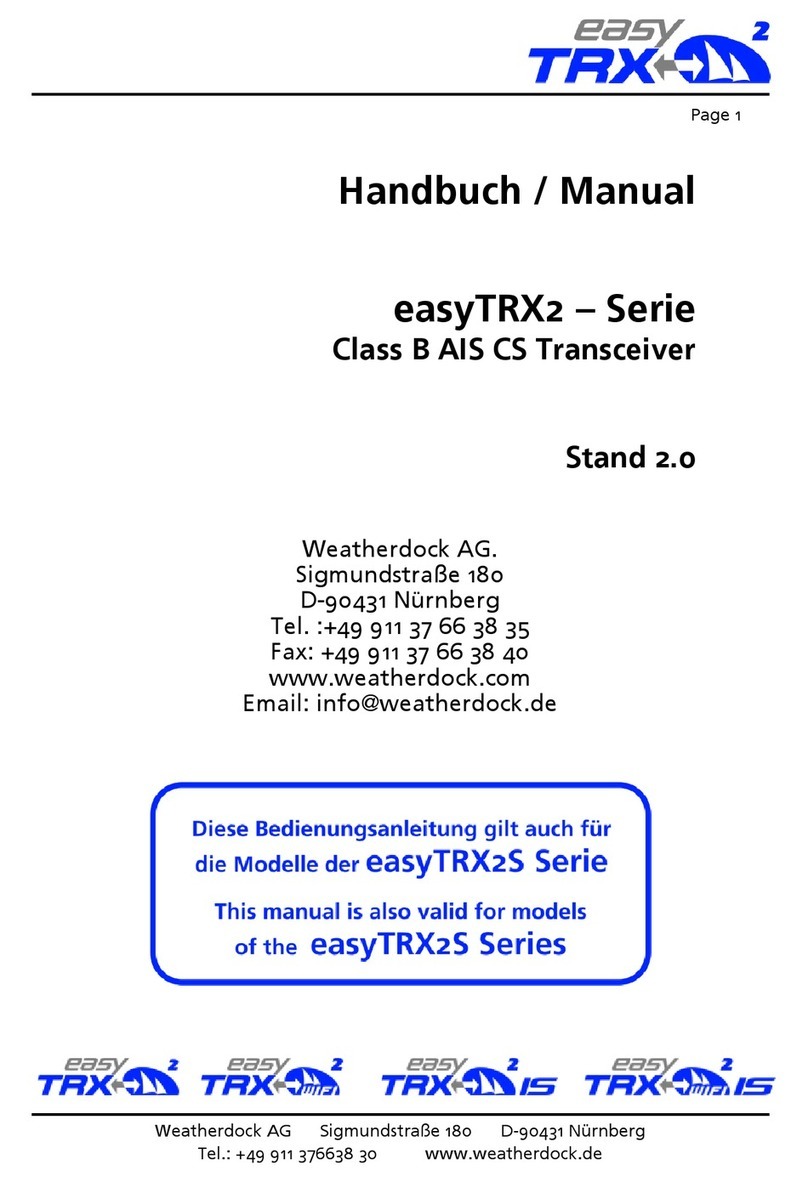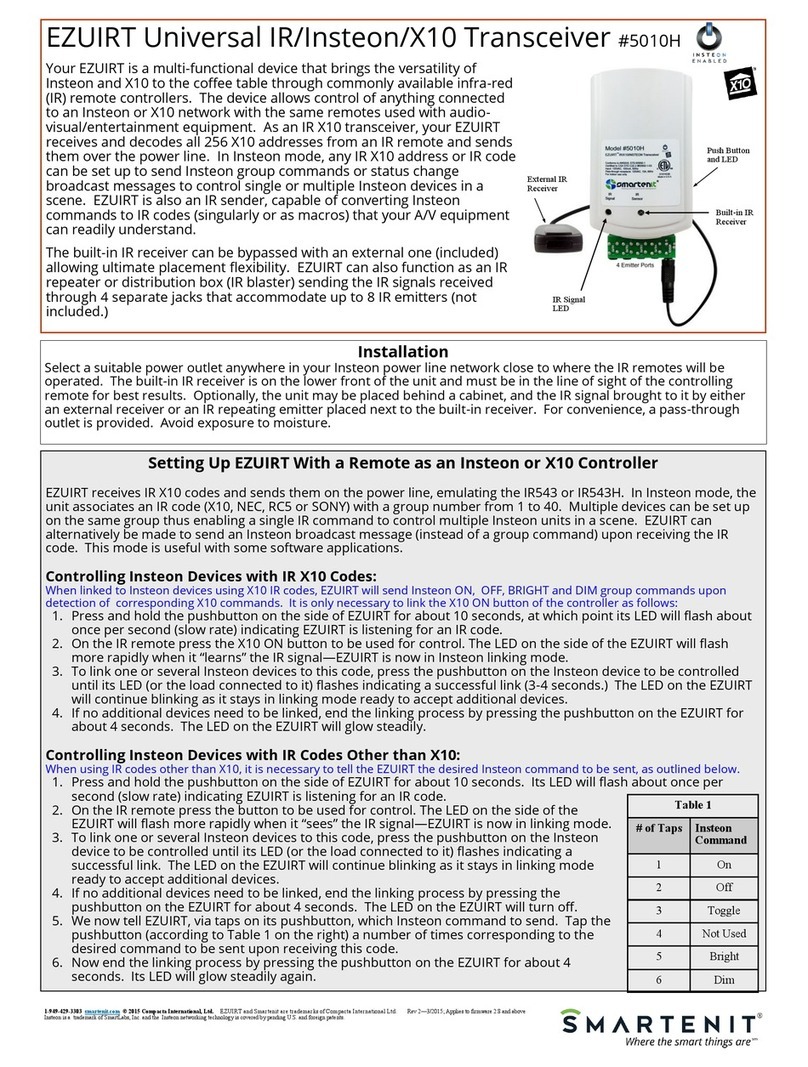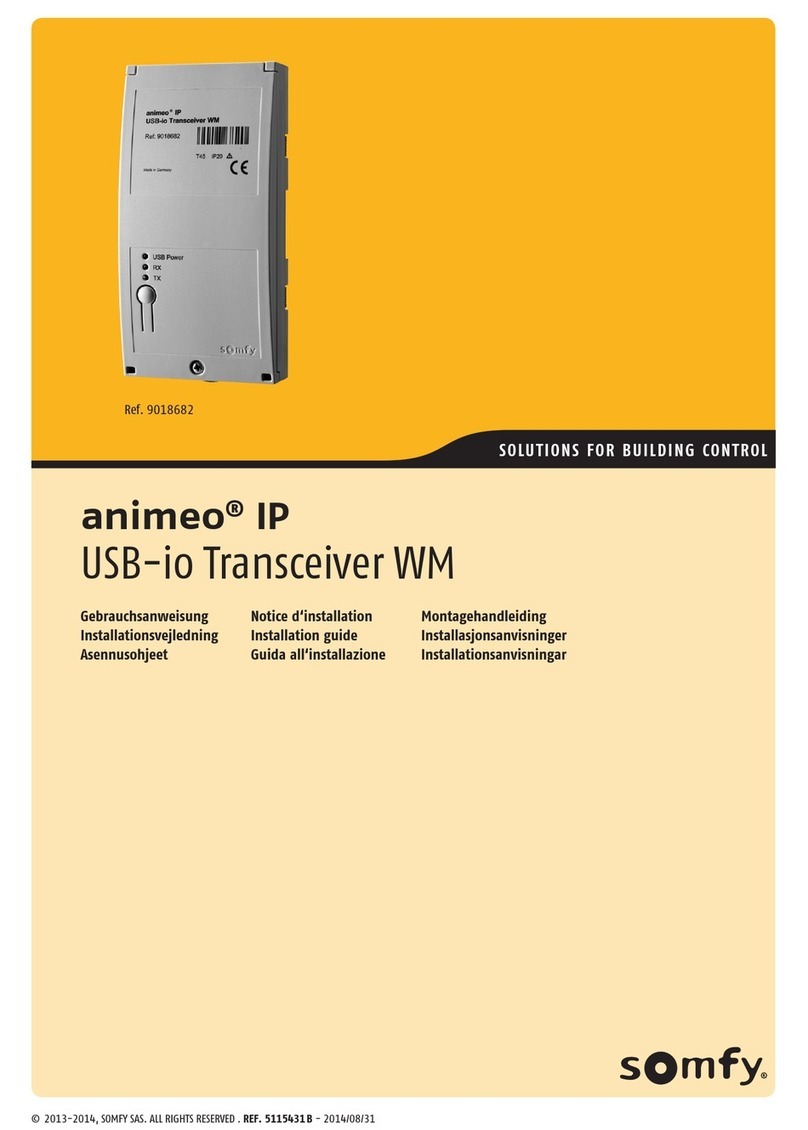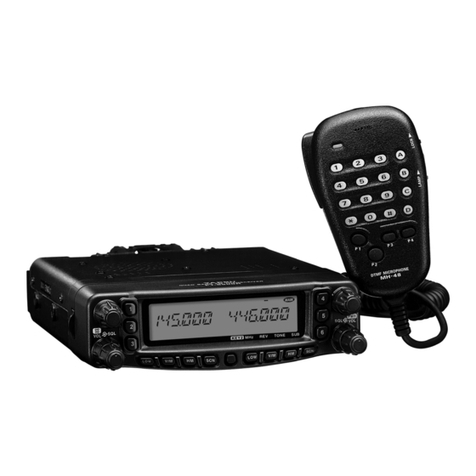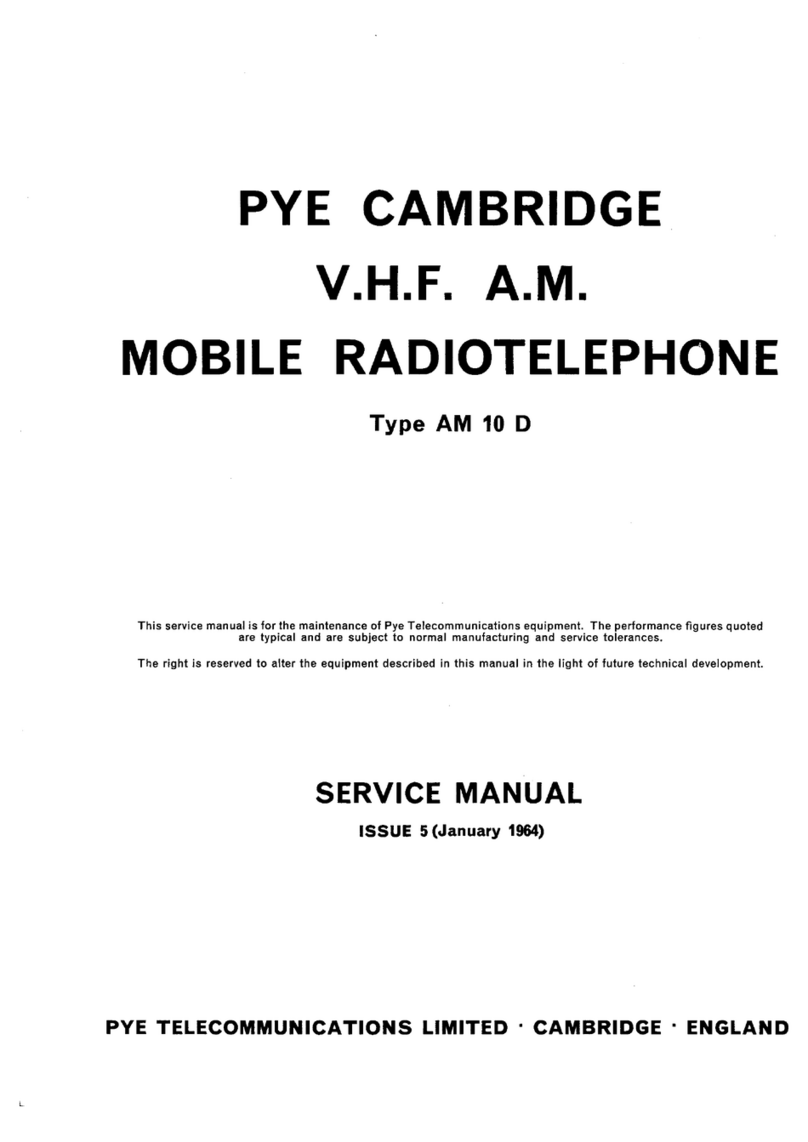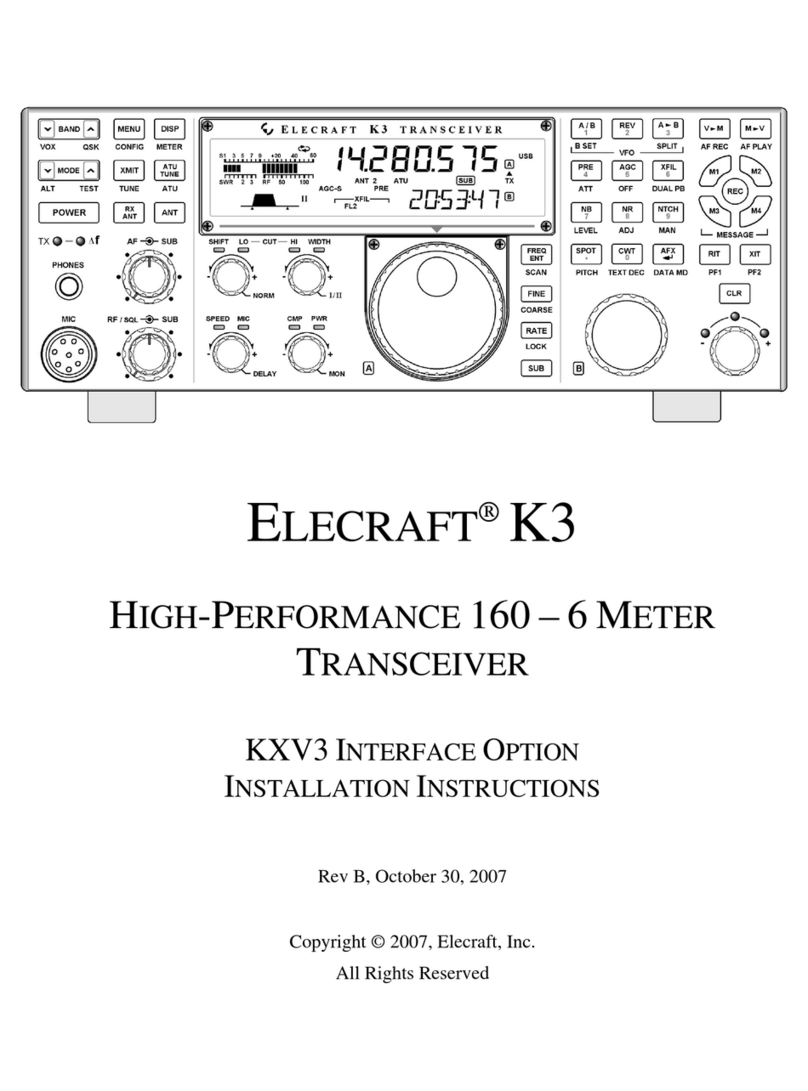Icom IC-F3230D User manual

RDANGER! NEVER short the terminals of the battery
pack. Shorting may occur if the terminals touch metal
objects such as a key, so be careful when placing the
battery packs (or the transceiver) in bags, and so on.
Carry them so that shorting cannot occur with metal
objects. Shorting may damage not only the battery pack,
but also the transceiver.
RDANGER! NEVER use or charge Icom battery packs
with non-Icom transceivers or non-Icom chargers. Only
Icom battery packs are tested and approved for use with
Icom transceivers or charged with Icom chargers. Using
third-party or counterfeit battery packs or chargers may
cause smoke, re, or cause the battery to burst.
RDANGER! NEVER operate the transceiver near
unshielded electrical blasting caps or in an explosive
atmosphere.
RWARNING! NEVER hold the transceiver so that the
antenna is very close to, or touching exposed parts of the
body, especially the face or eyes, while transmitting. The
transceiver will perform best if the microphone is 5 to 10
cm (2 to 4 inches) away from the lips and the transceiver
is vertical.
RWARNING! NEVER operate the transceiver with a
headset or other audio accessories at high volume levels.
The continuous high volume operation may cause a
ringing in your ears. If you experience the ringing, reduce
the volume level or discontinue use.
CAUTION: DO NOT use harsh solvents such as Benzine
or alcohol when cleaning. This could damage the
equipment surfaces. If the surface becomes dusty or dirty,
wipe it clean with a soft, dry cloth.
CAUTION: DO NOT place or leave the transceiver in
excessively dusty environments. This could damage the
transceiver.
CAUTION: DO NOT expose the transceiver to rain, snow
or any liquids. The transceiver meets IP67* requirements
for dust-tight and waterproof protection. However, once the
transceiver has been dropped, dust-tight and waterproof
protection cannot be guaranteed due to the fact that
the transceiver may be cracked, or the waterproof seal
damaged, and so on.
*Only when the jack cover or the optional HM-168LWP is
attached.
Your Icom radio generates RF electromagnetic
energy while transmitting. This radio is designed
for and classied as for “Occupational Use Only.”
This means it must be used only during the
course of employment by individuals aware of
the hazards, and the ways to minimize such hazards. This
radio is NOT intended for use by the “General Population”
in an uncontrolled environment. This radio has been tested
and complies with the FCC and IC RF exposure limits for
“Occupational Use Only”. In addition, your Icom radio
complies with the following Standards and Guidelines with
regard to RF energy and electromagnetic energy levels
and evaluation of such levels for exposure to humans:
• FCC OET Bulletin 65 Edition 97-01 Supplement C,
Evaluating Compliance with FCC Guidelines for Human
Exposure to Radio Frequency Electromagnetic Fields.
• American National Standards Institute (C95.1-1992),
IEEE Standard for Safety Levels with Respect to
Human Exposure to Radio Frequency Electromagnetic
Fields, 3 kHz to 300 GHz.
• American National Standards Institute (C95.3-1992),
IEEE Recommended Practice for the Measurement of
Potentially Hazardous Electromagnetic Fields– RF and
Microwave.
• The following accessories are authorized for use with
this product. Use of accessories other than those
specied may result in RF exposure levels exceeding
the FCC and IC requirements for wireless RF
exposure.; Belt Clip (MB-93, MB-94/R and MB-96N/F),
Rechargeable Li-ion Battery Pack (BP-232WP) and
Speaker-microphone (HM-158LA/HM-159LA/HM-
168LWP).
To ensure that your expose to RF
electromagnetic energy is within the FCC and IC
allowable limits for occupational use, always
adhere to the following guidelines:
DO NOT operate the radio without a proper antenna
attached, as this may damage the radio and may also
cause you to exceed FCC and IC RF exposure limits. A
proper antenna is the antenna supplied with this radio by
the manufacturer or an antenna specically authorized by
the manufacturer for use with this radio.
DO NOT transmit for more than 50% of the total radio use
time (“50% duty cycle”). Transmitting more than 50% of
the time can cause FCC and IC RF exposure compliance
requirements to be exceeded. The radio is transmitting
when the LED indicator lights red. You can cause the radio
to transmit by pushing the “PTT” switch.
ALWAYS keep the antenna at least 2.5 cm (1 inch) away
from the body when transmitting, and only use the Icom
belt-clips listed in “OPTIONS” of the INSTRUCTIONS
sheet when attaching the radio to your belt, or other
place, to ensure FCC and IC RF exposure compliance
requirements are not exceeded.
The information listed above provides the user with
the information needed to make him or her aware of
RF exposure, and what to do to assure that this radio
operates within the FCC and IC RF exposure limits of this
radio.
1-1-32 Kamiminami, Hirano-ku,
Osaka 547-0003, Japan
A7082D-1EX-4
Printed in Japan
© 2013–2018 Icom Inc.
Icom is not responsible for the destruction, damage to, or
performance of any Icom or non-Icom equipment, if the
malfunction is because of:
• Force majeure, including, but not limited to, res,
earthquakes, storms, oods, lightning, other natural
disasters, disturbances, riots, war, or radioactive
contamination.
• The use of Icom transceivers with any equipment that
is not manufactured or approved by Icom.
FCC INFORMATION
This equipment has been tested and found to comply with
the limits for a Class A digital device, pursuant to part 15
of the FCC Rules. These limits are designed to provide
reasonable protection against harmful interference when
the equipment is operated in a commercial environment.
This equipment generates, uses, and can radiate
radio frequency energy and, if not installed and used
in accordance with the instruction manual, may cause
harmful interference to radio communications. Operation
of this equipment in a residential area is likely to cause
harmful interference in which case the user will be
required to correct the interference at his own expense.
CAUTION: Changes or modications to this transceiver,
not expressly approved by Icom Inc., could void
your authority to operate this transceiver under FCC
regulations.
This device complies with Part 15 of the FCC Rules.
Operation is subject to the condition that this device does
not cause harmful interference.
RECOMMENDATION
CLEAN THE TRANSCEIVER THOROUGHLY IN A BOWL
OF FRESH WATER after exposure to saltwater, and dry
it before operating. Otherwise, the transceiver’s keys,
switches, and controllers may become unusable, due to
salt crystallization, and/or the charging terminals of the
battery pack may corrode.
NOTE: If the transceiver’s waterproof protection appears
defective, carefully clean the transceiver with a soft,
damp (fresh water) cloth, then dry it before operating. The
transceiver may lose its waterproof protection if the case,
jack cap, or connector cover is cracked or broken, or the
transceiver has been dropped.
Contact your Icom distributor or your dealer for advice.
VOICE CODING TECHNOLOGY
The AMBE+2™ voice coding Technology embodied in this
product is protected by intellectual property rights including
patent rights, copyrights and trade secrets of Digital Voice
Systems, Inc. This voice coding Technology is licensed
solely for use within this Communications Equipment.
The user of this Technology is explicitly prohibited from
attempting to extract, remove, decompile, reverse
engineer, or disassemble the Object Code, or in any other
way convert the Object Code into a human-readable form.
U.S. Patent Nos.
#8,595,002, #8,359,197, #8,315,860, #8,200,497,
#7,970,606, #6,912,495 B2.
Icom, Icom Inc. and the Icom logo are registered
trademarks of Icom Incorporated (Japan) in Japan, the
United States, the United Kingdom, Germany, France,
Spain, Russia, Australia, New Zealand, and/or other
countries.
AMBE+2 is a trademark and property of Digital Voice
Systems Inc.
All other products or brands are registered trademarks or
trademarks of their respective holders.
DO NOT place or leave the transceiver in direct sunlight or
in areas outside of the specied temperature range:
–30°C (–22°F) ~ +60°C (+140°F)
Keep the transceiver in a secure place to prevent use by
unauthorized persons.
DBattery caution
Misuse of Li-ion batteries may result in the following
hazards: smoke, re, or the battery may rupture. Misuse
can also cause damage to the battery or degradation of
battery performance.
RDANGER! NEVER solder the battery terminals, or
NEVER modify the battery pack. This may cause heat
generation, and the battery may burst, emit smoke or
catch re.
RDANGER! NEVER place or leave battery packs in
areas with temperatures above 60°C (140°F). High
temperature buildup in the battery cells, such as could
occur near res or stoves, inside a sun-heated vehicle,
or in direct sunlight for long periods of time may cause
the battery cells to rupture or catch re. Excessive
temperatures may also degrade the battery pack’s
performance or shorten the battery cell’s life.
RDANGER! NEVER strike or otherwise impact the
battery pack. Do not use the battery pack if it has been
severely impacted or dropped, or if the pack has been
subjected to heavy pressure. Battery pack damage may
not be visible on the outside of the case. Even if the
surface of the battery does not show cracks or any other
damage, the cells inside the battery may rupture or catch
re.
RDANGER! NEVER expose the battery pack to rain,
snow, seawater, or any other liquids. Do not charge or
use a wet pack. If the pack gets wet, be sure to wipe it dry
before using.
RDANGER! NEVER place or leave battery packs near
re. Fire or heat may cause them to rupture or explode.
Dispose of used battery packs in accordance with local
regulations.
RDANGER! NEVER let uid from inside the battery get
in your eyes. This can cause blindness. Rinse your eyes
with clean water, without rubbing them, and immediately
go to a doctor.
RWARNING! NEVER put the battery pack in a microwave
oven, high-pressure container, or in an induction heating
cooker. This could cause a re, overheating, or cause the
battery cells to rupture.
RWARNING! NEVER use the battery pack if it emits an
abnormal odor, heats up, or is discolored or deformed. If
any of these conditions occur, contact your Icom dealer or
distributor.
RWARNING! NEVER Iet uid from inside the battery cells
come in contact with your body. If it does, immediately
wash with clean water.
CAUTION: DO NOT use the battery pack out of the
specied temperature range for the transceiver (–30°C
~ +60°C (–22°F ~ +140°F)) and the battery itself (–20°C
~ +60°C (–4°F ~ +140°F)). Using the battery out of its
specied temperature range will reduce its performance
and battery cell’s life. Please note that the specied
temperature range of the battery may exceed that of the
transceiver. In such cases, the transceiver may not work
properly because it is out of its operating temperature
range.
CAUTION: DO NOT leave the pack fully charged,
completely discharged, or in an excessive temperature
environment (above 60°C, 140°F) for an extended
period of time. If the battery pack must be left unused
for a long time, it must be detached from the transceiver
after discharging. You may use the battery pack until the
remaining capacity is about half, then keep it safely in a
cool and dry place at the following temperature range:
–20°C ~ +50°C (–4°F ~ +122°F) (within a month)
–20°C ~ +40°C (–4°F ~ +104°F) (within three months)
–20°C ~ +20°C (–4°F ~ +68°F) (within a year)
BE SURE to replace the battery pack with a new one
approximately ve years after manufacturing, even if it still
holds a charge. The material inside the battery cells will
become weak after a period of time, even with little use.
The estimated number of times you can charge the pack
is between 300 and 500. Even when the pack appears to
be fully charged, the operating time of the transceiver may
become short when:
• Approximately 5 years have passed since the pack was
manufactured.
• The pack has been repeatedly charged.
DCharging caution
RDANGER! NEVER charge the battery pack in areas
with extremely high temperatures, such as near res or
stoves, inside a sun-heated vehicle, or in direct sunlight.
In such environments, the safety/protection circuit in the
battery will activate, causing the battery to stop charging.
RWARNING! NEVER charge the transceiver during a
lightning storm. It may result in an electric shock, cause
a re or damage the transceiver. Always disconnect the
power adapter before a storm.
RWARNING! NEVER charge or leave the battery in the
battery charger beyond the specied time for charging. If
the battery is not completely charged by the specied time,
stop charging and remove the battery from the battery
charger.
Continuing to charge the battery beyond the specied time
limit may cause a re, overheating, or the battery may
rupture.
RWARNING! NEVER insert the transceiver (battery
attached to the transceiver) into the charger if it is wet or
soiled. This could corrode the battery charger terminals or
damage the charger. The charger is not waterproof.
CAUTION: DO NOT charge the battery outside of the
specied temperature range:
BC-160/BC-171: (0˚C ~ 45˚C (32˚F ~ 113˚F))
BC-119N/BC-121N/BC-197: (10˚C ~ 40˚C (50˚F ~ 104˚F))
Otherwise, the charging time will be longer, but the battery
will not reach a full charge. While charging, at a point
after the temperature goes out of the specied range, the
charging will automatically stop.
PRECAUTIONS
PANEL DESCRIPTION
SAFETY TRAINING INFORMATION Electromagnetic Interference/Compatibility
During transmissions, your Icom radio generates RF
energy that can possibly cause interference with other
devices or systems. To avoid such interference, turn off
the radio in areas where signs are posted to do so. DO
NOT operate the transmitter in areas that are sensitive to
electromagnetic radiation such as hospitals, aircraft, and
blasting sites.
Occupational/Controlled Use
The radio transmitter is used in situations in which persons
are exposed as a consequence of their employment,
provided those persons are fully aware of the potential for
exposure and can exercise control over their exposure.
ATTACHING ACCESSORIES
DFlexible antenna
Connect the antenna to the antenna connector.
CAUTION:
•DO NOT carry the transceiver by holding only the
antenna.
•DO NOT connect an antenna other than those listed in
the INSTRUCTIONS.
• Transmitting without an antenna may damage the
transceiver.
DBattery pack
CAUTION: DO NOT attach or detach the battery pack
when the transceiver is wet or soiled. This may result in
water or dust getting into the transceiver/battery pack and
may damage the transceiver.
To attach:
Slide the battery pack in the direction of the arrow (1)
until the battery release button makes a ‘click’ sound.
NOTE: Push on the bottom of the pack to make sure the
release button is rmly locked.
To detach:
Slide the battery release button in the direction of the
arrow (2) as shown below. The battery pack is then
detached.
EXPLICIT DEFINITIONS
WORD DEFINITION
RDANGER! Personal death, serious injury or an
explosion may occur.
RWARNING! Personal injury, re hazard or electric
shock may occur.
CAUTION Equipment damage may occur.
NOTE If disregarded, inconvenience only. No
risk of personal injury, re or electric
shock.
IMPORTANT
This instruction sheet includes some functions that are
usable only when they are preset by your dealer. The
transceiver may have other functions and operations that
are not described in this instruction sheet. Ask your dealer
for preset function details.
VHF DIGITAL TRANSCEIVERS
Thank you for choosing this Icom product.
READ ALL INSTRUCTIONS carefully and completely
before using this product.
iF3230D Series
UHF DIGITAL TRANSCEIVERS
iF4230D Series
SUPPLIED ACCESSORIES
NOTE: Some accessories are not supplied, or the shape
is different, depending on the transceiver version.
Battery pack
Belt clip
Battery charger
Power adapter
Flexible antenna
Battery release button
1
2
[VOL]
External
microphone/
speaker jack
Speaker
[PTT]
[Side1]
[Emer]
[Side2]/
[Side3] [P0]/[P1]/
[P2]/[P3]
Function
Display
Microphone
Antenna
Connector
DAbout the External microphone/speaker jack
Connects to an optional speaker microphone or speaker.
CAUTION: DO NOT use the transceiver without the jack
cover or the optional equipment attached.
The transceiver meets IP67 requirements for dust-tight
and waterproof protection only when the jack cover or the
optional HM-168LWP is attached.
DAbout the Assignable key functions
NOTE: Your dealers can assign the functions to the keys
and keypads.
INSTRUCTIONS

FUNCTION DISPLAY
DTurning ON the transceiver
NOTE: Before using the transceiver for the rst time, the
battery pack must be fully charged for optimum life and
operation. See the BATTERY CHARGING section of this
sheet.
1. Rotate [VOL] to turn ON the transceiver.
2. If the transceiver is preset for a start up password,
enter the digit codes as directed by your dealer.
• The 10-keypad may be used for password input,
depending on the transceiver’s version.
• The keys in the table below can be used for password
input.
• The transceiver detects numbers in the same block
as identical. Therefore “01234” and “56789” are the
same.
KEY
NUMBER 0
5
4
9
3
8
2
7
1
6
[Side3]
[P0]/[P1]/
[P2]/[P3]
Side3
[VOL]
3. When the “PASSWORD” indication does not clear after
entering 4 digits, the entered code number may be
incorrect. Restart the transceiver in this case.
DReceiving and Transmitting
Receiving:
1. Push [CH Up] or [CH Down] to sequentially select the
conventional system channel.
2. When receiving a call, adjust the audio output level to
a comfortable listening level.
Transmitting:
CAUTION: Attach an antenna before transmitting.
Transmitting without an antenna may damage the
transceiver.
1. Wait until the channel is clear to avoid interference.
2. While holding down [PTT], speak at your normal voice
level.
3. Release [PTT] to receive.
IMPORTANT:
To maximize the readability of your signal:
1. After pushing [PTT], pause briefly before you start
speaking.
2. Hold the microphone 5 to 10 cm (2 to 4 inches) from
your mouth, then speak at your normal voice level.
BASIC OPERATION
BATTERY CHARGING
DRapid charging with the BC-160
The optional BC-160 rapidly charges the Li-ion battery
pack.
• A power adapter (may be supplied with BC-160,
depending on the version) or the DC power cable (OPC-
515L/CP-23L) is additionally required.
CAUTION: NEVER reverse the polarity when connecting
the OPC-515L to a power source. This will ruin the battery
charger.
White line: +, Black line: _
DAD-106 installation
The AD-106 CHARGER ADAPTER must be installed into
the BC-119N or BC-121N before battery charging.
1. Connect the AD-106 and the BC-119N or BC-121N.
2. Install the AD-106 into the holder space of the BC-
119N or BC-121N with the supplied screws.
Battery
Pack
Battery Pack
+ Transceiver
Turn OFF
Power Adapter*
The OPC-515L
(for a 13.8 V DC
power source)
or the CP-23L
(for a 12 V
cigarette lighter
socket) can be
used instead
of the power
adapter.
* A different type, or no power adapter is supplied,
depending on the charger version.
OPTIONS
DBATTERY PACK/BATTERY CASE
Battery
pack
Voltage Capacity Battery life*
BP-232WP 7.4 V 2250 mAh (min.)
2300 mAh (typ.)
VHF 19 hrs.
UHF 17 hrs.
* When the power save function is turned ON, and the
operating periods are calculated under the following
ratio:
TX : RX : standby = 5 : 5 : 90
•BP-240/BP-261 BATTERY CASE
BP-240: Battery case for 6 AAA (LR03) alkaline batteries
BP-261: Battery case for 6 AA (LR6) alkaline batteries
BP-240 and BP-261 have IPX4 waterproof protection.
When in use, the transceiver’s waterproof rating meets
IPX4. Operating period depends on the alkaline cells used.
DCHARGERS
•BC-119N DESKTOP CHARGER + AD-106 CHARGER
ADAPTER + BC-145S AC ADAPTER
To rapidly charge the battery pack. A power adapter may
supplied with the charger, depending on the versions.
Charging time: Approximately 3.5 hours for the BP-232WP.
•BC-121N MULTI-CHARGER + AD-106 CHARGER
ADAPTER (6 pcs.) + BC-157S AC ADAPTER
For rapidly charging of up to 6 battery packs
simultaneously. A power adapter should be purchased
separately.
Charging time: Approximately 3.5 hours for the BP-232WP.
•BC-160 DESKTOP CHARGER +
BC-123S AC ADAPTER
To rapidly charge the battery pack. A power adapter may
be supplied with the charger, depending on the versions.
Charging time: Approximately 3.5 hours for the BP-232WP.
•BC-171 DESKTOP CHARGER +
BC-147S AC ADAPTER
A power adapter may supplied with the charger, depending
on the versions.
Charging time: Approximately 11.5 hours for the BP-232WP.
•BC-197 MULTI-CHARGER
For rapidly charging of up to 6 battery packs
simultaneously. A power adapter may be supplied with the
charger, depending on the version.
Charging time: Approximately 3.5 hours for the BP-232WP.
DDC CABLES
•CP-23L CIGARETTE LIGHTER CABLE
Used when charging a battery pack through a 12 V
cigarette lighter socket. (For BC-160/BC-171/BC-119N)
•OPC-515L/OPC-656 DC POWER CABLES
Used when charging a battery pack through a 13.8 V
power source instead of the power adapter.
OPC-515L: For BC-119N/BC-160/BC-171
OPC-656: For BC-121N/BC-197
DBELT CLIPS
•MB-93 SWIVEL BELT CLIP
•MB-94/MB-94R BELT CLIP
Exclusive alligator-type belt clip.
•MB-96N/MB-96F LEATHER BELT HANGER
ATTACHING ACCESSORIES (Continued)
DBelt clip
To attach:
1. Remove the battery pack from the transceiver, if it is
attached.
2. Slide the belt clip in the direction of the arrow until the
belt clip is locked and makes a ‘click’ sound.
To detach:
Lift the tab up (1), and slide the belt clip in the direction of
the arrow (2).
BE CAREFUL! DO NOT break your ngernail
DOTHERS
•HM-158LA/HM-159LA/HM-168LWP SPEAKER-
MICROPHONE
Combination speaker-microphone that provides
convenient operation while hanging the transceiver on
your belt.
•HM-166LA EARPHONE-MICROPHONE
Ideal for hands-free operation: clip the HM-166LA (with
integrated PTT switch) to your lapel or breast pocket.
Allows you to operate in rainy conditions.
•FA-SC25V/FA-SC55V/FA-SC25U/FA-SC57U/
FA-SC72U/FA-SC62V/FA-SC63V/FA-SC03U
ANTENNAS
FA-SC25V: 136–150 MHz FA-SC55V: 150–174 MHz
FA-SC25U: 400–430 MHz FA-SC57U: 430–470 MHz
FA-SC72U: 470–520 MHz FA-SC62V: 150–160 MHz
FA-SC63V: 155–165 MHz FA-SC03U: 380–430 MHz
• FA-SC56VS/FA-SC57VS/FA-SC73US
STUBBY ANTENNAS
FA-SC56VS: 150–162 MHz FA-SC57VS: 160–174 MHz
FA-SC73US: 450–490 MHz
•FA-SC61VC/FA-SC61UC CUT ANTENNAS
FA-SC61VC: 136–174 MHz FA-SC61UC: 380–520 MHz
•MB-130 VEHICLE CHARGER BRACKET
Mounts the BC-160 DESKTOP CHARGER onto variety of
places in a vehicle.
Some options may not be available in some countries. Ask
your dealer for details.
1
2
1 432 5 6 7 8
9
1
TRANSMIT ICON
Displayed while transmitting.
2BUSY ICON
Displayed while the channel is busy (receiving).
3SIGNAL STRENGTH ICON
Shows the relative receive signal strength level.
Weak StrongReceive signal level
About “ ” icon for the Trunking mode:
• Disappears while in a no service area.
• Blinks while registering to a repeater.
• Displayed when registration is completed.
4LOW POWER ICON
Displayed when low output power is selected.
L When the battery power decreases to a specied
level, low power is automatically selected.
5AUDIBLE ICON
• In the analog mode, displayed when the CTCSS
(DTCS) squelch mute is released while holding down
[Monitor].
• In the digital mode, displayed while holding down
[Monitor].
6ENCRYPTION ICON
In the digital mode, displayed when the encryption
function is activated.
7BELL ICON
In the digital mode, displayed/blinks when an SDM
(Short Data Message), Status Call or Call Alert is
received, depending on the presetting.
8KEY LOCK ICON
Displayed when the Key lock function is ON.
9BATTERY ICON
Displayed or blinks when the battery power decreases
to a specied level.
ALPHANUMERIC DISPLAY
Displays an operating channel number, channel name,
User Set mode contents, and so on.
DRegular charging with the BC-171
The optional BC-171 regularly charges the Li-ion battery
pack.
• A power adapter (may be supplied with BC-171,
depending on the version) or the DC power cable (OPC-
515L/CP-23L) is additionally required.
Battery Pack
+ Transceiver
Turn OFF
Battery
Pack
Power Adapter*
The OPC-515L
(for a 13.8 V DC
power source)
or the CP-23L
(for a 12 V
cigarette lighter
socket) can be
used instead
of the power
adapter.
* A different type, or no power adapter is supplied,
depending on the charger version.
AD-106 Plugs
Sockets
Screws
supplied with
the charger
adapter.
DRapid charging with the BC-119N+AD-106
The optional BC-119N rapidly charges the Li-ion battery
pack. The following items are additionally required.
• AD-106 CHARGER ADAPTER
• A power adapter (may be supplied with the BC-119N,
depending on the version) or the DC power cable
(OPC-515L/CP-23L). Battery Pack
+ Transceiver
Turn OFF
Battery
Pack
Power Adapter*
The OPC-515L (for
a 13.8 V DC power
source) or the CP-23L
(for a 12 V cigarette
lighter socket) can be
used instead of the
power adapter.
* A different type, or no power adapter is supplied,
depending on the charger version.
Other manuals for IC-F3230D
2
This manual suits for next models
1
Other Icom Transceiver manuals
Popular Transceiver manuals by other brands
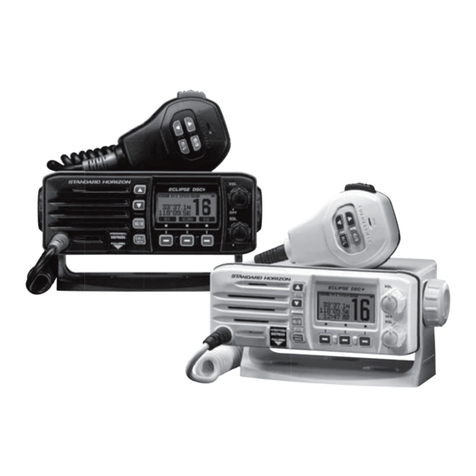
Standard Horizon
Standard Horizon Eclipse DSC+ GX1200 owner's manual

MFJ
MFJ MFJ-9200 instruction manual

Expert Electronics
Expert Electronics SunSDR2 DX quick start guide
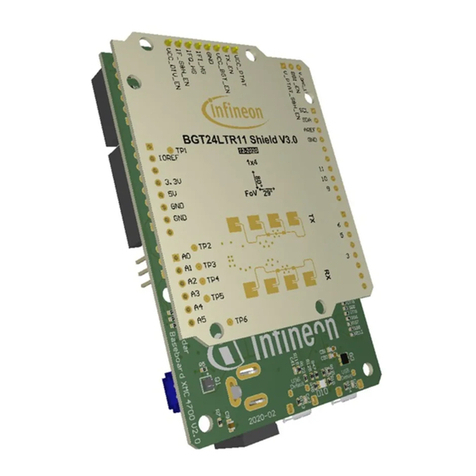
Infineon
Infineon BGT24LTR11 manual
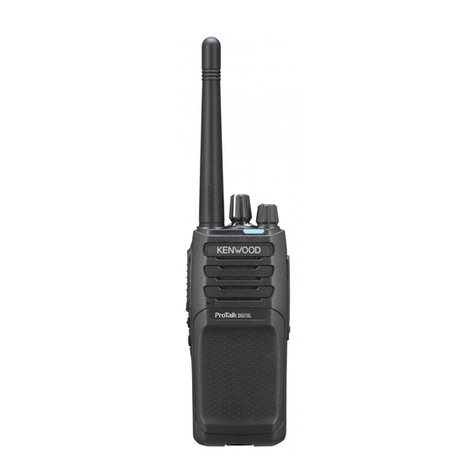
Kenwood
Kenwood ProTalk DIGITAL NX-P1200NV user manual
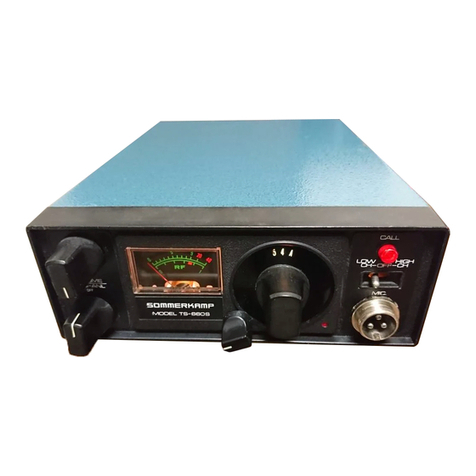
Sommerkamp
Sommerkamp TS-660S instruction manual
